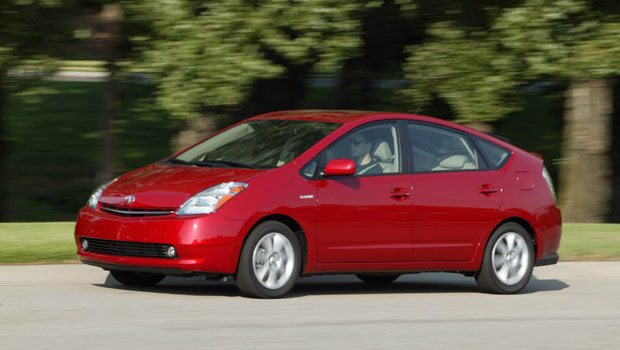If any car can be called a game changer, it’s certainly the Prius. When we had a look at the Prius hybrid technology, our first thought was “How has nobody thought of that before?” The technology is simple, yet brilliant. The small transmission unit has just a few gears and two small electric motors. However, not only does it take care of gear ratio changing, but it also re-generates electricity and smoothly combines the power of a gasoline engine and electric motor. Thanks to this technology, the Prius is one of the most fuel efficient cars for the last 15 years. It’s also the best-selling hybrid, and is widely available on the used car market. Is the Prius dependable in the long run? How reliable is the hybrid technology? How expensive are the maintenance and repairs? We will try to answer all these questions in this review.
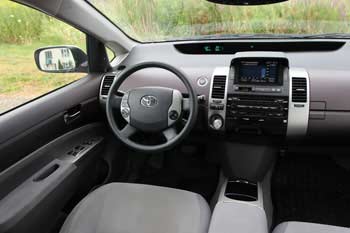
Toyota Prius 2004 interior.
|
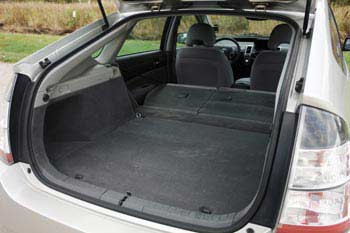
Toyota Prius 2004 interior.
|
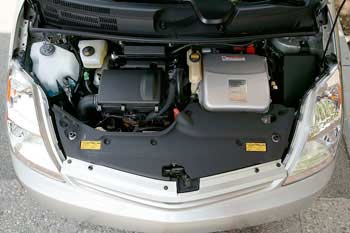
Toyota Prius 2005 engine. Photo: Toyota.
|
Powertrain: The Prius’s 1.5L gasoline engine is very similar to that of Toyota Yaris, but is modified for hybrid powertrain. The hybrid “transmission” unit contains two electric motors that can work as generators. One electric motor controls the gear ratio and recharges the hybrid battery. The second motor propels the vehicle at low speeds and supplies additional power on acceleration. The second motor is also used to recover energy when braking or coasting. Scroll down to the ‘Resources’ section for more detailed info. The hybrid battery is placed under the trunk floor, see the photo below.
Fuel Economy: The EPA rates the 2004-2009 Prius at 48 MPG city, 45 MPG highway and 46 MPG combined. It’s actually not that difficult to get these numbers in real world conditions. In fact, the best fuel economy we were able to get out of this 2004 Prius is 54.6 MPG combined (4.3 L/100km). On a one-day road trip we easily got 469 miles (755 km) on a 11.9-gallon tank (45 liters). According to the EPA estimate, if you drive 15,000 miles per year, you will spend only around $1,100 on fuel for the whole year. For comparison, the annual estimated fuel cost for the 2008 V6 Ford Escape is $2,350.
Timing belt or chain: The 2004-2009 Prius engine has a maintenace-free timing chain, there is no timing belt.
Handling and ride: The Prius handles well but not sporty. The ride is soft and fairly quiet. Thanks to the torquey electric motor, the Prius is actually quick off the line. You will also appreciate the small turning radius and good all-around visibility.
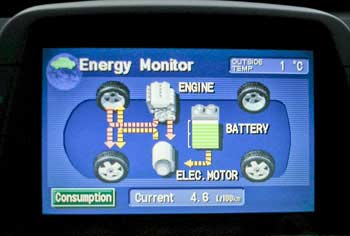
Toyota Prius energy monitor.
|
How the hybrid powertrain works: When you start moving slowly, the car drives on the electric power alone. As you accelerate past 15-20 mph, the gasoline engine kicks in. All this happens very smooth, you just hear the engine start running. When you stop at the red light, the engine shuts off. As you step on the gas, it kicks in again. At first, all this seems a bit weird, but after driving for a few days you don’t even notice it. When you coast or lightly apply brakes, the transmission unit re-generates the energy to charge up the hybrid battery. You can see the power flow on the center display.
Driving the Prius in cold seasons: First, the bad news: the low clearance makes it difficult to drive the Prius in deep snow. The fuel economy suffers too: gas mileage drops to 38-39 MPG combined. Now, the good news: we drove the Prius many times in snowy and icy conditions and it felt pretty stable. It looks like the weight of the hybrid battery over the rear axle adds some stability on slippery roads. It seems that the tail doesn’t spin out as easily as in a typical front-wheel drive car. Another advantage is that it takes only a couple minutes to fill up the Prius at a gas station because of it’s small gas tank.
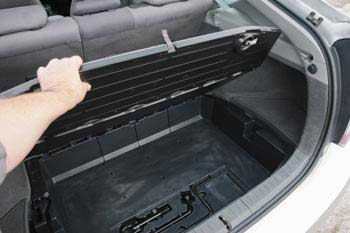
Toyota Prius cargo bin.
|
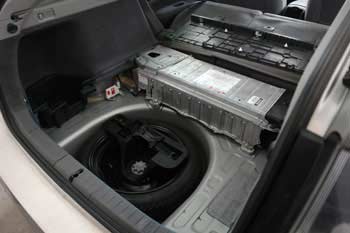
Toyota Prius hybrid battery
|
Maintenance costs: The Prius is actually not very expensive to maintain. Why? Tires are cheap: $336-$464 per set on TireRack.com. Brakes last much longer than in a regular car because of regenerative braking. There is no alternator and there is only one tiny drive belt that drives the water pump. The belt itself costs less than $20 and takes a few minutes to replace. The Prius engine runs on conventional 5W-30 oil and takes only 3.9 qt. (3.7 liters) of it. Oil changes need to be done every 3,000-5,000 miles, depending on your preference. An air filter costs around $20 and is very easy to change. The cabin filter is also easy to replace (it needs to be replaced every 30,000 miles or more often if driving on dusty roads)
Hybrid system maintenance: The hybrid system doesn’t really need any special maintenance. The 2008 Prius maintenance schedule mentions changing inverter coolant at 100,000 miles and every 50,000 miles thereafter and inspecting the transmission fluid every 30,000 miles. In our 2004 Prius, we changed hybrid transmission fluid at 60,000 miles and it wasn’t even dirty.
Hybrid battery: First of all, according to many sources, the hybrid battery doesn’t fail very often. Even this 2004 Prius still has the original battery. According to the 2008 Prius owner’s warranty information, hybrid battery, hybrid control module and inverter with converter are covered for 8 years or 100,000 miles. The California Emission Control warranty for the hybrid battery goes even further: 10 years or 150,000 miles. Replacing a hybrid battery at a dealership will be quite expensive ($3,500-3,800 parts and labor), but there are plenty of alternatives. For example, we found that a used or remanufactured hybrid battery can be purchased on eBay for around $1,000. Some owners mention replacing separate battery modules (which of course should be done only by a qualified technician observing all safety precautions). The 2004-2009 Prius has 28 individual modules in the battery pack and we found separate modules sold on eBay for $26-$38.
Pros: Fuel economy, spacious cabin, visibility, front headroom, cargo space, large storage bin, low maintenance, takes a very little time to fill up, extra weight on the rear axle keeps it more stable on slippery roads, brakes last longer.
Cons: Lack of driver’s seat height adjustment, interior materials could be better, low clearance.
Common problems: There are several often mentioned problems. In the early 2004-2005 Prius models the Multi Function Display unit may become inoperative. The first symptom is when the display at times doesn’t show the state of charge of the battery and becomes slow to react. The 2004 Prius we used for this review actually starts showing this problem. Thanks to the author of this post for taking time and posting details on the DIU repair. The Toyota solution is to replace the unit, which is quite expensive, although there are remanufactured and used units available on eBay and other sites.
A leaking engine water pump is mentioned often, the repair is not very expensive ($350-$450).
HID headlights seems to be another trouble spot, so if you have a choice, opting for a model without HIDs might not be a bad idea. The first symptom is that HIDs start flickering and work intermittently. Toyota parts are expensive, but alternatives are available. A failed wheel bearing may cause a humming or rumbling noise. Replacement of the wheel bearing may cost $350-$480.
Overall: The Prius is an excellent choice to save money on fuel, especially if you have to drive a lot. There is a small risk of expensive hybrid system repairs, but fuel savings are quite significant. Most Prius owners are quite happy with their cars. One of the questions in the annual Consumer Reports survey is “would you get this car if you had it to do all over again? Guess what, 85 percent of a 5-year old (2008) Prius owners answered “Yes” which is the highest rating among small cars; read more in this CR article. Overall the Prius is very reliable. Aside from that, it’s a very practical car with a spacious interior and plenty of cargo space.
What to look for when buying a used Toyota Prius: The Prius has plenty of electronics and should definitely be avoided if the history report shows that the vehicle has been involved in an accident or flooded in the past. The main question buyers of used hybrid cars have is what is the condition of the hybrid battery. Unfortunately, there is no simple way to test the hybrid battery; even the procedure described in Toyota technical literature for technicians is quite complicated and time-consuming.
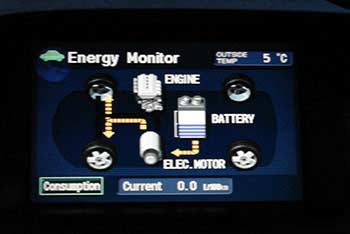
Toyota Prius state of charge.
|
What you can do is to test drive the Prius in all modes: slow on battery power alone, accelerating, coasting and decelerating. The battery state of charge is shown in bars on the center display. As you know, over time any battery loses some of its capacity. A battery with lower capacity will not hold the charge well and will drain faster with use. It’s difficult to tell how good is the Prius battery just by looking at the power flow monitor, but if you test-drive several vehicles, you might be able to see the difference. A battery with lower capacity may drain notably faster under similar conditions. We did a little test with this Prius. We found an empty road and tried to drive it with the A/C off at slow speed (under 15 mph) so it will run on battery power only. The battery state of charge dropped from 6 bars to 4 bars after driving for just under one mile. Beside, that, the Prius needs to be inspected similarly to any other car.

